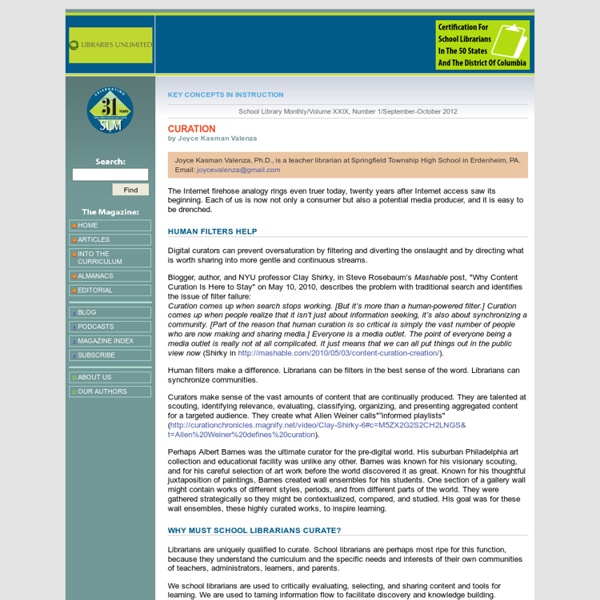Content Curation Primer
Photo by Stuck in Customs What is Content Curation? Content curation is the process of sorting through the vast amounts of content on the web and presenting it in a meaningful and organized way around a specific theme. The work involves sifting, sorting, arranging, and publishing information. A content curator cherry picks the best content that is important and relevant to share with their community. It isn’t unlike what a museum curator does to produce an exhibition: They identify the theme, they provide the context, they decide which paintings to hang on the wall, how they should be annotated, and how they should be displayed for the public. Content curation is not about collecting links or being an information pack rat, it is more about putting them into a context with organization, annotation, and presentation. People and organizations are now making and sharing media and content all over the social web. Content Curation Provides Value from the Inside Out Getting Started
Free Technology for Teachers
Developing Future Workskills Through Content Curation
July 27, 2012 Come to my session at ISTE 2016: “Personalize Learning With Student Curation” 6/28 4:00 – 5:00 CCC 113, Table 2 The response to my previous post on Understanding Content Curation has been incredible. passionate about. I have enjoyed exploring the many links and sources that were shared via Scoop-It, Pinterests, blogs, and other connections to my post. One link in particular has helped move my thinking forward regarding the benefits for students who curate: the Apollo Research Institute Future Workskills 2020 study conducted last year that identifies critical workforce skills that our students will need to be prepared for future jobs. A closer look suggests that critical workforce skills identified in this \ study can be easily aligned with the skills practiced with content curation. Sensemaking “ability to determine the deeper meaning or significance of what is being expressed” Transdisciplinarity “literacy in and ability to understand concepts across multiple disciplines”
Content curation: ricerca, selezione, apprendimento
La content curation, secondo Robin Good, esperto in materia, è “l’arte di selezionare il meglio”. Una vera e propria metodologia di ricerca, raccolta, organizzazione e cura delle informazioni, utile a condividere risorse su specifici argomenti. Attività che mi appassiona molto e che, a pensarci bene, ho sempre svolto senza esserne pienamente consapevole… photo credits: Patrick Goethe via unsplash.com Sto parlando, in particolare, dell’abitudine di ritagliare, suddividere e archiviare pagine di giornali, trafiletti, immagini e chi più ne ha più ne metta. Produrre contenuti, infatti, è solo una parte del mio lavoro: prima di scrivere un articolo è necessario uno studio approfondito dell’argomento da trattare. Content curation: aggiornarsi e aggiornare Personalizzare i contenuti Cercare le fonti, selezionare le più valide, suddividerle per tema: un lavoro certosino, che acquista valore se arricchito da ulteriori informazioni e commenti. Content curation: canali e strumenti
The Newbery Project
Understanding Content Curation
July 7, 2012 Come to my session at ISTE 2016: “Personalize Learning With Student Curation” 6/28 4:00 – 5:00 CCC 113, Table 2 There are many buzzwords and phrases prevalent in education today. “21st Century Learning”, “Blended Learning”, “Personalized Learning”, “Flipped Classroom” – just to name a few. I manage a grant project in my district designed to assure students acquire “21st century skills” A current strategy for this is using backwards design, formative assessments of 21st century skills, and “blended-learning.” This curiosity led to further questions: Why curate? Collecting vs. I set out to read as much as possible of what others have written on the subject, (see my Scoop-It on Curating Learning Resources) to help with my understanding. Defining Curating in Education by Nancy White is licensed under a Creative Commons Attribution 4.0 International License. Thinking Level Process Organization Value Audience Students as Content Curators
Penna Blu - Sara Durantini: Cura dei contenuti
Questo è un guest post scritto da Sara Durantini. Scrivere sul web non è cosa semplice. Ne ho parlato nel precedente guest post, indicando le linee guida per presentare informazioni il più possibile complete. Ma per essere tale, l’informazione deve essere curata anche sul piano dei contenuti. L’argomento merita un post a sé. Premessa Quando si parla di cura dei contenuti ci si riferisce alla pratica attraverso cui vengono raccolti, analizzati e presentati contenuti informativi. Il discorso coinvolge tanto i blogger e i giornalisti quanto i cittadini che, occasionalmente, vogliono condividere notizie sul web. Operazioni preliminari Gli step da seguire per curare i contenuti: Raccogliere: cercare e ricercare, stilare liste, salvare le ricerche attorno a una notizia o informazione da condividere. Facciamo il punto Riflettiamo La guest blogger Autore: Guest blogger (48 articoli) Questo post è stato scritto da un collaboratore. Lasciami la tua opinione Nome e email devono essere reali.
Watch. Connect. Read.



